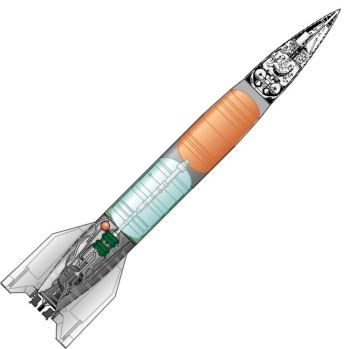
Home - Search - Browse - Alphabetic Index: 0- 1- 2- 3- 4- 5- 6- 7- 8- 9
A- B- C- D- E- F- G- H- I- J- K- L- M- N- O- P- Q- R- S- T- U- V- W- X- Y- Z
Tikhonravov Suborbital
 Tikhonravov V-2 Credit: © Mark Wade |
Status: Study 1946. Payload: 1,000 kg (2,200 lb). Thrust: 265.00 kN (59,574 lbf). Gross mass: 14,000 kg (30,000 lb). Unfuelled mass: 4,500 kg (9,900 lb). Specific impulse: 239 s. Specific impulse sea level: 203 s. Burn time: 77 s. Height: 16.00 m (52.00 ft). Diameter: 1.65 m (5.41 ft). Span: 3.56 m (11.67 ft). Apogee: 150 km (90 mi).
In the spring of 1946 the Soviet Union had reactivated a significant portion of the German V-2 research and production facilities. Under Soviet supervision, 330 workers were completing final assembly of V-2's at the former V-2 repair facility at the Kleinbodungen. At the main production facility at Nordhausen, 26 km west, more workers slaved away underground producing V-2's. The numbers employed were a significant fraction of the peak Nazi concentration camp workforce.
The original intention was to mass produce V-2's in Germany. This included development and fight-test of advanced versions. Evidently concerned about the security of such operations so far west, Stalin and Beria secretly planned to move both production and design to Russian territory. To this end they issued a decree on 13 May 1946 putting Minister of Armaments Dmitri Ustinov in charge of creating a Russian ballistic missile industry. Production of the Soviet version of the V-2 engine would be undertaken under Mikhail Khrunichev's Ministry of Aviation Industry at Glushko's facility at Khimki.
It was in this context that Soviet rocket pioneer Mikhail Tikhonravov proposed the first Soviet manned spacecraft. He drew up a proposal with rocket propulsion specialist Nikolai Chernyshev. After having the design reviewed by a multi-agency expert commission, Khrunichev forwarded the concept to Stalin on 20 June 1946, endorsing its feasibility.
Tikhonravov proposed using a stretched V-2 with the propellant load increased from 8 to 9 metric tons. This would allow ascent with a crew of two men to 100-150 km altitude. It was foreseen that the engine compartment would be jettisoned prior to the descent. The main technical issue was the safe descent to earth.
10-15 of these modified V-2 rockets would be manufactured to Tikhonravov's design in Germany at the V-2 plants in Nordhausen. Engine stand tests and unmanned flight tests would also be conducted in Germany.
Khrunichev's Ministry of Aviation Industry would be responsible for manufacture of the pressurized manned capsule. It would be necessary to obtain 'more experienced' (German?) professionals to assist so that it could be completed within a two year schedule. Design and fabrication of the cabin would take place at Glushko's plant.
The letter to Stalin included a draft decree to implement the program. This was never acted on, as completely different plans were afoot. Khrunichev and Tikhonravov apparently did not know that Stalin had decided to shut down V-2 facilities in Germany and move the whole enterprise to Russia. Key German personnel were shipped to Russia on the night of 22-23 October 1946. All V-2 facilities on German soil were closed down and the equipment, including a few dozen completed V-2's, shipped to Russia. Stalin only approved further development after these had been tested at Kapustin Yar in the fall of 1947. New Russian-built V-2's (R-1's) did not start test until 1948 and only became operational in 1950. Some R-1's were modified to carry dogs into space and finally flown in 1954-1956. But these used smaller-diameter capsules than Tikhonravov's design and were incapable of carrying a human being.
People: Manned V-2. Country: Russia. Engines: Model 39. Propellants: Lox/Alcohol. Bibliography: 13399.
Back to top of page
Home - Search - Browse - Alphabetic Index: 0- 1- 2- 3- 4- 5- 6- 7- 8- 9
A- B- C- D- E- F- G- H- I- J- K- L- M- N- O- P- Q- R- S- T- U- V- W- X- Y- Z
© 1997-2019 Mark Wade - Contact
© / Conditions for Use